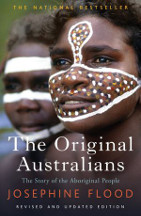The original Australians, the story of the Aboriginal people by Josephine Flood

Allen and Unwin, 2019. Revised and updated edition. ISBN:
9781760527075.
(Age: 16+) Non-fiction. Flood writes that her book was provoked by
requests from overseas friends for an introduction to Indigenous
Australia, and that she wanted to provide an informative and
objective account of Aboriginal history and culture that could be
read by the general public. She started out by collecting the kinds
of questions that people asked, such as where the First Australians
came from, their impact on the environment, was traditional life
idyllic, why were treaties not made, were Aboriginal children
'stolen', etc.
The resulting book begins with how Aboriginal society was gradually
discovered by the outside world, and thus starts with first contact
between foreigners and Aborigines. So we learn about the Dutch
encounters in the late 16th and early 17th century, the accounts of
Englishman William Dampier, and the trading relationship with the
Macassans, Indonesian fishermen, all before the arrival of Captain
Cook.
Other chapters are titled Colonisation, early Sydney; Confrontation,
in Tasmania and Victoria; Depopulation, a century of struggle
(1820s-1920s); Tradition, Indigenous life at first contact; Origins,
the last 65,000 years; Assimilation, a time of trouble
(1930s-1970s); and Resurgence, the story continues.
Clearly it is a mammoth task to write such a book. She is successful
in keeping the tone accessible to the general reader, at the same
time providing well referenced notes, and including various maps and
a collection of coloured prints of artworks and photographs
including ancient rock art sites. Surprisingly she does not include
the map of Indigenous language or tribal groups, an invaluable tool
in helping people to understand the diversity and number of
Aboriginal groups, and their 'Country', the places they were
connected to.
Some areas where there may be some dispute about Flood's account of
Aboriginal life may be in her assertion of their hunter-gather
lifestyle, ignoring recent interpretations of their cultivation and
agricultural methods, and also the assertion that Aboriginal
languages have no numbers beyond 3 or 4, ignoring the complexities
of Indigenous mathematical understandings that other writers are
exploring in the field of ethnomathematics.
Flood also takes issue with the word 'stolen' as applied to
Aboriginal children, and highlights the cases where Aboriginal
mothers gave their children into care; undermining the concept of
'stolen generations' and the ramifications for Aboriginal families.
And in the final chapter, Resurgence, in her description of the
Intervention, in highlighting views of the benefits to Aborigines of
the welfare card, she ignores any conflicting view of the impact on
their lives.
Flood ends on an optimistic point, in that whilst Prime Minister
Turnbull rejected out of hand the Uluru Statement from the Heart,
possibly new Prime Minister Morrison may come closer to giving the
First Nations people a voice in government.
Dr Josephine Flood is an expert archaeologist so this volume is a
worthy addition to the literature on Aboriginal Australians; however
the non-expert reader may be a little wary of generalisations made
about a people who are a diverse group with varying opinions on some
of the topics covered.
Helen Eddy